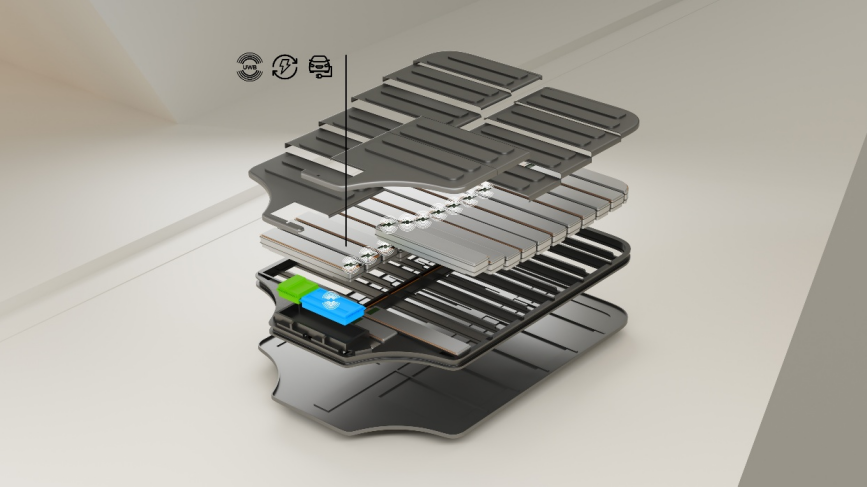NXP unveils first ultra-wideband wireless battery management system solution
2024-11-27 09:51:48 1200
NXP's ultra-wideband (UWB) wireless battery management system (BMS) simplifies electric vehicle assembly, improves battery energy density and separates mechanical and electrical development for faster time-to-market
Trimension UWB resists reflections and frequency-selective fading within the battery pack more effectively than existing narrowband technologies, ensuring more stable and reliable data transmission
The solution is part of NXP's FlexCom chipset, which supports both wired and wireless BMS configurations with a common software architecture and security libraries.

Figure. 1
Electronica, Munich, Germany - November 25, 2024 - NXP Semiconductors N.V., which recently announced a new generation of radio battery management system (BMS) solutions, has the NXP has one of the industry's broadest UWB product portfolios, with solutions that integrate the power of UWB. The next-generation UWB BMS solution is the next step in overcoming development challenges and is designed to accelerate electric vehicle (EV) adoption by addressing costly and complex processes in manufacturing.
Wireless communication within the battery pack enables stable and reliable transmission of battery cell information, such as voltage and temperature, from individual modules to the battery management unit without the need for wiring, thereby guaranteeing excellent performance and preventing conditions that lead to premature failure or safety hazards.
NXP UWB wireless BMS technology separates the mechanical and electrical development process, electric vehicle manufacturers can increase flexibility, accelerate the time-to-market process, reduce costs, while maintaining a full range of system scalability on different platforms.
The wireless solution minimizes complex wiring within the battery pack, reduces error-prone manual operations during production, improves EV assembly efficiency, and reduces overall lifecycle costs. By eliminating connectors and wiring between battery cells, energy density is increased, a key parameter in EV performance design for extended range.
Our wireless battery management system solution incorporating UWB technology is the first attempt in the market to provide electric vehicle manufacturers with an advanced technology solution to support the future of electric vehicles,” said Naomi Smit, vice president and general manager, Battery Management Systems, NXP Semiconductors. trimension UWB provides simple, secure and robust wireless communication within the BMS, going beyond existing narrowband-based solutions. We are proud to work hand-in-hand with our customers to deliver on the promise of wireless technology.”
Realizing wireless technology inside the reflective housing of a battery pack is challenging. uWB uses high-bandwidth pulses, rather than modulated carrier frequencies (sinusoidal signals) found in narrowband 2.4 GHz technologies such as low-power Bluetooth® (BLE), which improves its resistance to reflections and frequency-selective attenuation and ensures a more stable and reliable data transmission.
NXP's ultra-wideband radio pool management system solution will be available to OEMs for evaluation and development in the second quarter of 2025.
The solution is part of NXP's FlexCom chipset, which supports both wired and wireless technologies, providing OEMs and Tier 1 suppliers with richer and more flexible vehicle architectures and technology options. Its common software architecture and security libraries for both BMS configurations enable customers to reuse software across platforms, further reducing development efforts.
NXP MC33777 battery junction box IC
The NXP FlexCom BMS chipset also includes its recently released MC33777 Battery Junction Box (BJB) IC for high-voltage systems, which provides accurate voltage, high-voltage insulation detection and current measurement. The BJB is included in NXP's complete one-stop battery management system solution for corded and cordless battery management solutions, and is compatible with NXP's software and applications, eliminating the need for manufacturers to add additional branding for this purpose.
NXP Electrification Solutions
NXP Electrification Solutions manage the flow of energy throughout the electrification ecosystem, including electric vehicles, homes and buildings, and smart grids. In electric vehicles, flexibility and accuracy enable our customers to extend driving range and keep vehicles on the road longer. NXP Electrification Solutions encompasses complete EV system solutions, including battery cell controllers, battery junction boxes, communication gateways and microcontrollers, dedicated to providing OEMs with the optimized performance and integrated safety they need.




